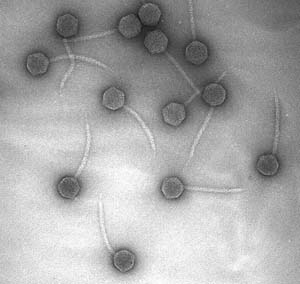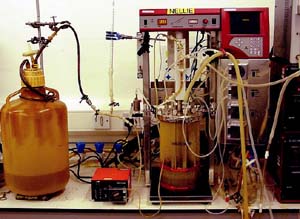The therapeutic potential of bacteriophages (bacterial viruses) was first recognised in the early 20th century. However, with the advent of antibiotic prophylaxis, Western scientists paid little attention to the potential for bacteriophages to combat infection. By contrast, in many eastern European countries from the former Soviet bloc, bacteriophages were used in preference to antibiotics to combat bacterial pathogens. Recently such therapies have regained popularity in the West and many lytic bacteriophages, that is those which destroy their host cells, are being investigated as potential anti-microbials.
 Bacteriophage lambda particles (x150,000)
However, many bacteria harbour in their chromosomes the genetic material for bacteriophages. These bacteria are known as lysogens and their so-called temperate bacteriophages can be stably maintained for many generations. In food fermentation processes, temperate bacteriophages of starter cultures are seen as little more than an industrial nuisance when they occasionally trigger a lytic cycle, begin proliferation and arrest bacterial growth and production. If similar genetic elements are present in food-poisoning or pathogenic bacteria, and if they can be persuaded to replicate and limit host growth, then a potentially simple and novel method for protecting food against the activity of unwanted bacteria could be devised.
Bacteriophage lambda particles (x150,000)
However, many bacteria harbour in their chromosomes the genetic material for bacteriophages. These bacteria are known as lysogens and their so-called temperate bacteriophages can be stably maintained for many generations. In food fermentation processes, temperate bacteriophages of starter cultures are seen as little more than an industrial nuisance when they occasionally trigger a lytic cycle, begin proliferation and arrest bacterial growth and production. If similar genetic elements are present in food-poisoning or pathogenic bacteria, and if they can be persuaded to replicate and limit host growth, then a potentially simple and novel method for protecting food against the activity of unwanted bacteria could be devised.
 Continuous culture apparatus (chemostat)
In the Food Science Laboratories at QUB, experiments have been carried out using a continuous culture (chemostat) system in order to mimic bacterial growth in food storage conditions. In chemostats, nutrients are fed to the culture at a defined rate which specifies the growth rate of the cells. Other growth parameters, such as pH, temperature and oxygen concentration can then be defined by maintaining constant conditions. This allows the effects of external parameters on bacterial cultures to be measured independently of growth rate. We are able, for example, to measure the effect of common treatments used to preserve food on temperate bacteriophage induction in pathogenic bacteria. Such treatments include manipulating the external pH, temperature, extra-cellular salt concentration and cellular osmolarity.
Continuous culture apparatus (chemostat)
In the Food Science Laboratories at QUB, experiments have been carried out using a continuous culture (chemostat) system in order to mimic bacterial growth in food storage conditions. In chemostats, nutrients are fed to the culture at a defined rate which specifies the growth rate of the cells. Other growth parameters, such as pH, temperature and oxygen concentration can then be defined by maintaining constant conditions. This allows the effects of external parameters on bacterial cultures to be measured independently of growth rate. We are able, for example, to measure the effect of common treatments used to preserve food on temperate bacteriophage induction in pathogenic bacteria. Such treatments include manipulating the external pH, temperature, extra-cellular salt concentration and cellular osmolarity.
It has been shown that bacteriophages from
Escherichia coli
and
Staphylococcus aureus
can indeed be induced using food-compatible methods and that microbial populations decline as a result. Thus it might be possible to develop a novel holistic approach to limiting the proliferation of microbial pathogens in foods by exploiting the intrinsic elements existing in many bacterial genomes, which were once thought of as little more than genetic fossils.
Contact: Dr Martin Collins, Department of Food Science
(Food Microbiology), Queen's University Belfast;
Tel. 028-90255314; Fax 028-90255009;
E-mail:
[email protected]
|


